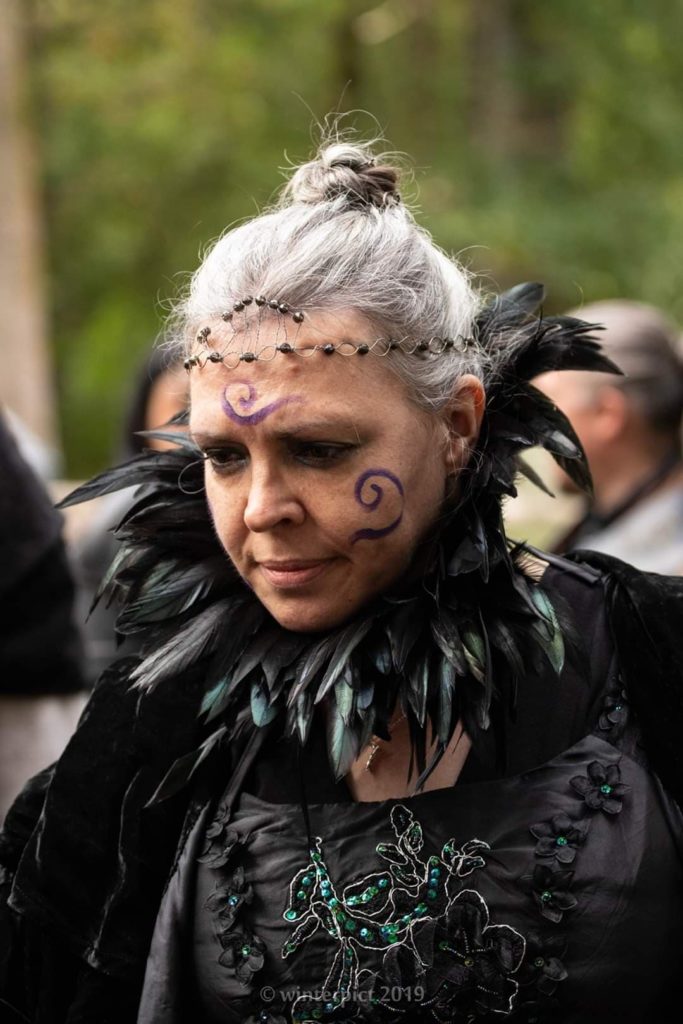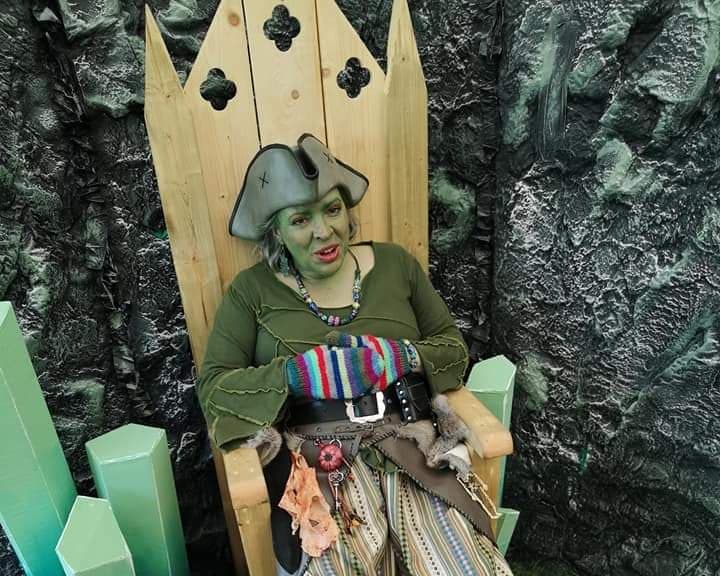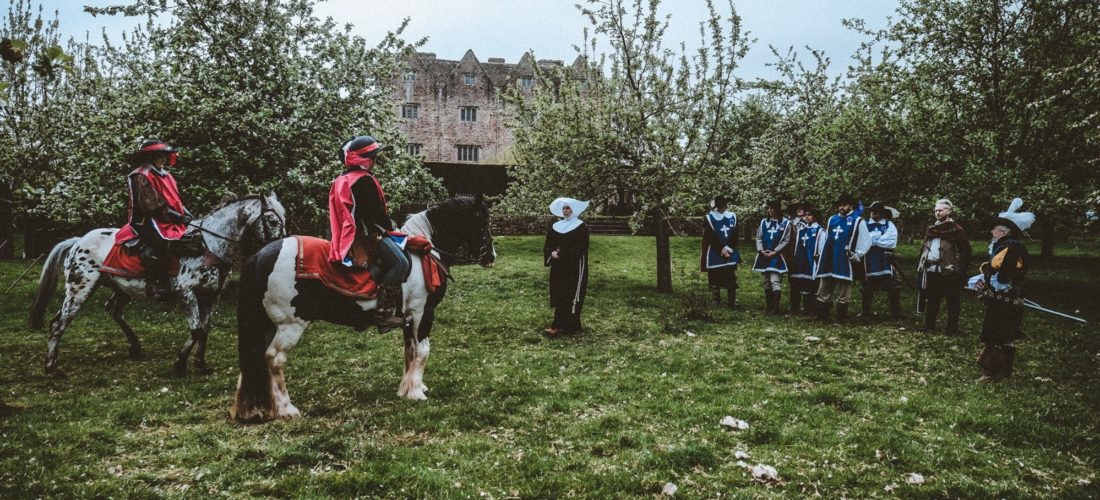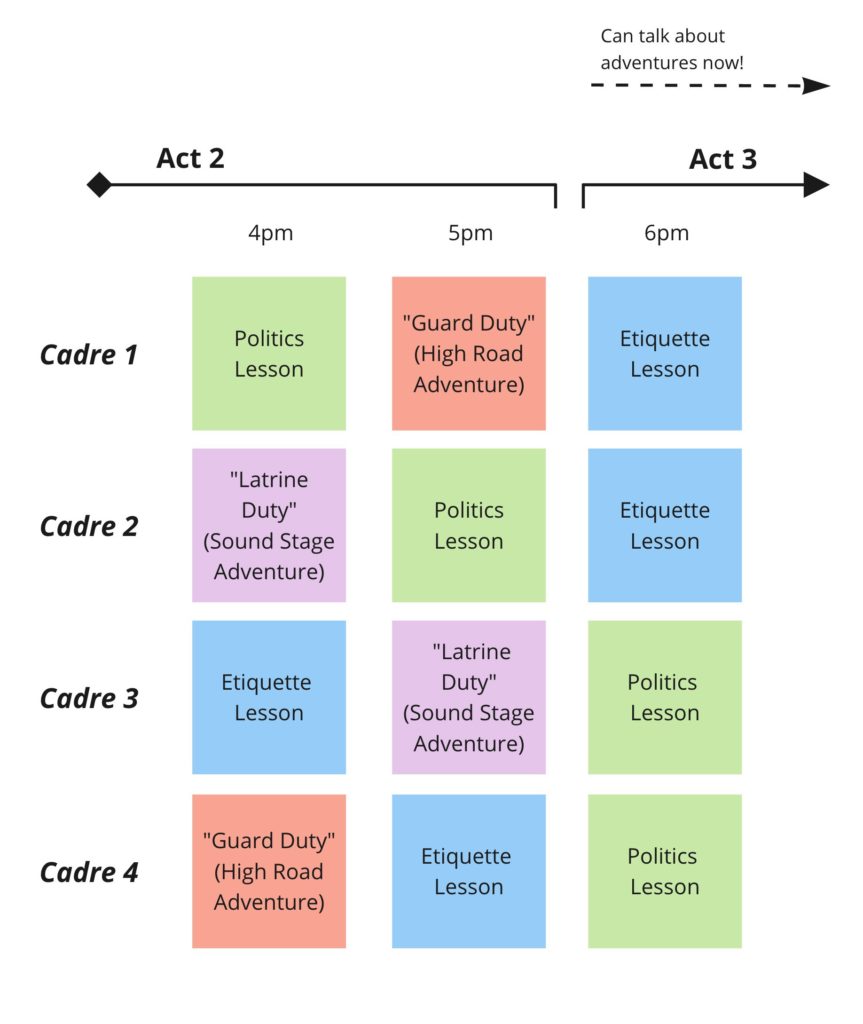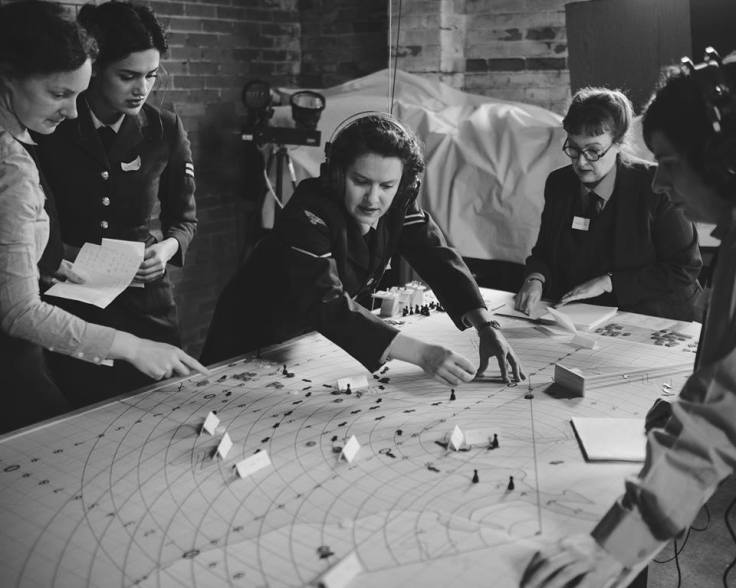
Jamie Hall is a larp designer, based in the UK. He has been writing and refereeing larp campaigns since the early 2000’s: NEXUS, Carum Live Roleplay, and more recently, Strange LRP. He likes simple systems that generate complex outcomes.
“An auteur is a director who is considered the most important figure in the art of filmmaking, a creative person equivalent to an author of a novel or a play…[They control] all aspects of filmmaking. [The term] originated in France in the early 1950s”.
Constantine Santas (2002, p18) “Responding to Film: A Text Guide for Students of Cinema Art” Rowman & Littlefield. ISBN 978-0-8304-1580-9
The idea of the auteur is an easy one to grasp. The director of a film is usually the most important credit. The author of a novel is assumed to have created the story entirely from their own imagination. The designer of a computer game decides what can happen, and what can’t. As consumers of stories in various media, we are conditioned to accept the idea of an authority figure (often male), who has the vision and ambition to create.
In some circumstances, the creator is a true auteur: a novel without an editor or proof-reader; a play that is written, directed and performed by a single person; a film in which every process is overseen by the director. In most cases, the reality is more collaborative. For example, editors can have a significant influence on a novel, and cinematographers and sound engineers have their own artistic intuitions.
Larp is a new medium which is interactive, and collaborative. It has similarities with oral storytelling, theatre, tabletop games, computer games, and sports. All of these have uncertain outcomes, and might develop each time they are performed. This is in contrast to a novel, or a film, which has been finished, and is experienced passively.
Instead, the particpants at a larp are actively engaged in a process of self-organisation or ‘spontaneous order’, in which they simultaneously create and respond to interaction, typically acting within the parameters estalished by the organisers (eg. ‘this is a 1920’s larp’, or, ‘you are a shamanic ritualist’), but ultimately making their own decisions about where, when, and why they interact.
The larp itself is process of self-organisation, and each moment of the larp is a process of self-organisation, allowing the particants to look back on the progress of their narratives, and create or modify their plots in response.
A larp organiser might consider themselves to be an auteur, and control every aspect of the logistics, but by the nature of larp, they are not the only participant; they cannot control the actions of the players, and in particular, the memories of the players. Once the larp begins, the players will respond to what is happening around them, regardless of the intentions of the organiser.
The larp system also has a memory, albeit an unreliable one. After each event and after each interaction information is encoded; primarily in the minds of the participants, who can refer back to their previous interactions and the actions of other participants. It is unreliable because the players experience subjective narratives, and while the organiser may have a better grasp of the story it is hard or impossible to make an objective record of everything that has taken place (instead, organisers typically collect some data, eg. who has died, which rituals have been cast, whether the statue has been stolen from the temple).
No two larps are ever the same. Even if the larp is composed of the same places, people, objects, and ideas, a second run will deliver a different outcome to the first. This is because the story is not a component of the system, but an emergent property of it – something that does not exist within the design of the larp system, or the minds of the participants, and instead develops as the larp is played.
Terms such as “non-linear”, “player-led”, and “character-driven” are often used interchangeably to describe an “emergent” story, but it should be noted that the story is always emergent, even if the larp has a linear structure, if crew characters are running the show, or if the organiser plot is paramount. Each term is useful, and all of them point to a need for freedom – the end result of any larp is the combined effort of dozens, hundreds, or even thousands of participants, who (consciously or unconsciously) engage in the process of self-organisation.
Stories and narratives are, by nature, retrospective. If a participant thinks about them or describes them, they are describing what has happened in the past. At a larp interactions are hard to predict, therefore, the outcomes of stories and narratives are hard to predict. The story is objective, in that things either happened or did not happen, but neither players, crew, or organisers have a truly objective view of it. Instead, they understand it subjectively, through individual narratives.
When a participant is thinking about the future, it is not story or narrative, but plot. ‘Plot’ is often discussed as if it is a voyage being marked onto a map, but in this context, it really refers to “plotting and scheming”. Organisers and players must be able to plot. That is, they must be able to conceive plans for future action, based on information about the system (ie. the setting, the rules, things that have already happened). Organisers have a rich array of tools to plot with – they can create and destroy characters, objects, and locations. Players are only able to plan for their own actions, and rely on agency to affect the actions of others.
Agency is integral to larp. It is the “self” in “self-organising”. A participant without agency is unable to affect change, and therefore cannot contribute to the emergent story. Their individual narrative is likely to consist of numerous interruptions, which will occur every time their attempted changes are ignored or over-ruled by the organisers. The larp is not judged by how ‘good’ the story is, but how many individuals ‘enjoyed’ their experience, and give a positive review. Therefore, the role of the organiser is not to create a ‘good’ story, but to facilitate ‘enjoyable’ experiences among the other participants.

To understand agency, consider a larp without it. The characters would be scripted, the outcomes would be decided by the organisers, and in-character decisions would be ignored or redacted. The players would be actors in a play – or if they were only allowed to observe the roleplay of others, then they would be the audience at a play.
Most larps have some limits on agency. By the time the larp begins, the participants will have an idea of what the larp is about, based on information provided by the organisers. This is subjective, and will vary between participants without causing problems. A participant with strongly divergent ideas can cause a crisis of agency for themselves, or others.
When designing a larp, the organisers should attempt to describe their ideas as clearly as possible, with an emphasis on the iconic aspects of the larp. For example, “Tudor nobles gather for a meeting of their secret cult”. Beyond that point, they should concede that the players have a natural agency, and further, they should make efforts to enhance that natural agency. For example, granting social status or abilities to particular characters, and validating them (“The bailiffs follow the instructions of the nobles, even if the nobles have committed a crime”, or “The cultists perform the ritual, and a demon does appear”).
The organisers do not need to validate every interaction. Instead they should concentrate on validating the areas of enhanced agency that they have described during the design phase. In this way, the players know the limits and scope of their natural agency (and receive minimal interruption from the organisers), and can rely on the organisers to support the iconic aspects of the larp, which would otherwise be beyond the grasp of the players.
As the organisers have a limited awareness of what the players are doing, they must be careful not to undermine the agency of the players by accident. That is not to say that the organisers should have no influence. Instead, it is a matter of scale. Once the larp is in progress, they should respond to the data they collect, but the response should be on the scale of the players, using characters, objects and ideas.
This can involve subverting the player’s assumptions, but it should not override their efforts. This is the critical point when considering agency – an interaction is best understood by those who participated in it, and invalidating that interaction (intentionally or accidentally) is an attack on the agency of the players.
Designing a larp is designing a system. It is not a hard system, but a soft system – one in which the active components are human participants. As explained above, it is difficult or impossible to establish centralised control of interactions within the system. A larp system does not provide reliable outcomes, and the thoughts, words, and movements of the participants are usually beyond the control of the organisers.
A larp is nonetheless a cluster of control subsystems, which define the norms and meanings of various other components. For example, a 1920’s historal setting defines the norms for costume. Rules for a fantasy larp could describe a system of elemental magic, thereby defining the meanings of certain symbols and colours.
The participants rely on this common set of norms and meanings, which are foundational, but need minimal enforcement – typically, a participant will come to a 1920’s larp because the era and the costumes appeal to them. Likewise, they will learn the magical lore because they want to play as a magician, and know the things that magicians know.
This foundation exists before the larp takes place, and serves a dual purpose, which is to provide common norms and meanings, as well as appealling to potential participants, who must be convinced to attend, and spend their money. The iconic aspects of the larp provide a ‘unique selling point’, as well as encouraging particular styles of play, and types of interaction.
The foundation could be minimal, or extensive, but it must be reliable in any case, as the participants will plan their initial interactions based on the information provided. Their initial sense of agency will be driven by their ability to assess the larp, and make plans for the future.
This initial sense of agency is important, and the start of a larp can be a moment of crisis – “I want to be a charismatic politician, but I don’t actually know who I should talk to”. Various methods are used to avoid a negative outcome, as this can persist throughout the larp. For example, written or verbal briefings, pre-larp workshops, or a planned set piece.
Once the initial crisis is over, what then? Pressure can be applied by the organisers – more briefings, more workshops, more set pieces. This is the agency of the organiser, which can be used to great effect. For the other participants, this external influence can be jarring, either interrupting their experience, or bypassing their own agency.
If autocratic control is removed, how can the initial momentum of the players develop into an emergent story? The social behaviour of humans can be relied upon to provide some interaction, even in the absence of the organisers. This social behaviour is the engine that drives all the interaction that takes place within the larp, and initial momentum (eg. “I have lots of money”, or “My wife has just been murdered”) is met with a range of responses from the other participants, whether they are moral, logical, or emotional.
In addition, the norms and meanings provided by the organiser can enhance and amplify the interaction of the participants on an ongoing basis. In the UK, this is what we usually call “setting” and “rules”, which must be designed to generate interesting roleplay, or risk hindering it instead.

For example, a positive effect might be one that encourages a strong bond between two characters, or encourages more people to debate and trade together, or encourages the resolution of a conflict, while a negative effect might come from enforced social isolation (diminished social stature, hours of solitary meditation, or feuds that never end).
Each character has a series of meanings attached to them (eg. Police officer, magician, grieving widow), and will tend to gravitate towards participants with resonant or dissonant meanings attached (eg. the police will tend to work together but oppose the mobsters, the magicians will covet each other’s grimoires, grief-stricken characters will console one another).
No two participants are ever really the same, and as the number of participants increases, the range of meanings will tend to expand. If there are two police officers, perhaps one will be honest, and one will be corrupt. If there are numerous police officers, then the meanings can exhibit greater variety (“She is taking bribes to pay for medical treatment for her dying mother, but he does it to pay off gambling debts”, or “He is a hard-working honest cop, waiting for retirement, but she is focused on promotion, and rooting out corruption).
The attempt to resolve these resonant and dissonant meanings – against a complex backdrop provided by the other participants – encourages interactions that involve morality, sacrifice, desire and all sorts of drama.
Meanings can also be attached to props (eg. an ancient ritual dagger), furniture (“Only the Queen may sit upon the throne”), and the site itself (“This room is the bar”, or “All rituals must be performed in that glade”). These inanimate entities cannot process meanings themselves, but the participants can make use of them to achieve resolution (“Priests search the woodland, and interrupt the ritual”, or “My ancestral sword has been stolen!”). Documents are a particularly effective tool, as they can provide detailed meanings, and encourage discussion and argument. For example, a scroll that describes a demonic ritual will offend some by its mere existence, some will wish to study it, while others will desire to perform the ritual. As it explicitly invokes a specific control sub-system, it can encourage and validate interaction at the same time, with minimal interruption by the organisers.
Ideas are the intangible cousins of inanimate objects. They only exist in the minds of the participants, but they are nonetheless a powerful force. A rumour, whether introduced by the organisers or the other participants, can spread like a virus. If a secret exists, then there is roleplay to be had from learning it, keeping it, sharing it, or being oblivious to it.
Though ideas are intangible, they are the driving force that binds the participants, props, and site together. The setting of a larp might be epic (“Vast empires wage war with dragons”), or intimate (“The family have dinner together, and discuss whether to move house”), but it will in any case be a tangle of resonant and dissonant meanings.
The resulting stories are complex, and collaborative, but they happen at a very human scale, utilising bodies and minds, objects and places, They are stories that evolve, just as the history of the world evolves – as an emergent property of countless simple actions, and without the controlling hand of a single creator.
Larp is uniquely able to tell these kinds of complex and collaborative stories as the product of diverse participants, creating a story through action and reaction, instead of intention. As creative agents (whether organisers, crew, or players) we should abandon our preconceptions of control, embrace the emergent story, and celebrate the death of the auteur.


